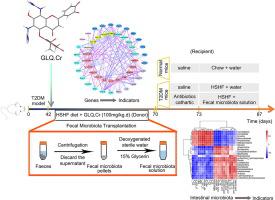Journal of Advanced Research ( IF 11.4 ) Pub Date : 2022-06-11 , DOI: 10.1016/j.jare.2022.06.003 Xiaodong Ge 1 , Xiaoyu He 2 , Junwei Liu 3 , Feng Zeng 1 , Ligen Chen 3 , Wei Xu 3 , Rong Shao 3 , Ying Huang 1 , Mohamed A Farag 4 , Esra Capanoglu 5 , Hesham R El-Seedi 6 , Chao Zhao 7 , Bin Liu 8

|
Introduction
Luteolin is a plant-derived flavonoid that exhibits a broad range of pharmacological activities. Studies on luteolin have mainly focused on its use for hyperlipidaemia prevention, whereas the capacity of the flavonoid to hinder hyperglycaemia development remains underexplored.
Objectives
To probe the anti-hyperglycemic mechanism of 6,8-guanidyl luteolin quinone-chromium coordination (GLQ.Cr), and to assess its regulatory effect on intestinal microbiota in type 2 diabetes mellitus (T2DM) mice.
Methods
High-sucrose/high-fat diet-induced and intraperitoneal injection of streptozotocin was used to develop a T2DM model. Glycometabolism related indicators, histopathology, and gut microbiota composition in caecum samples were evaluated, and RNA sequencing (RNA-seq) of liver samples was conducted. Faecal microbiota transplantation (FMT) was further used to verify the anti-hyperglycemic activity of intestinal microbiota.
Results
The administration of GLQ.Cr alleviated hyperglycaemia symptoms by improving liver and pancreatic functions and modulating gut microbe communities (Lactobacillus, Alistipes, Parabacteroides, Lachnoclostridium, and Desulfovibrio). RNA-seq analysis showed that GLQ.Cr mainly affected the peroxisome proliferative activated receptor (PPAR) signalling pathway in order to regulate abnormal glucose metabolism. FMT significantly modulated the abundance of Lactobacillus, Alloprevotella, Alistipes, Bacteroides, Ruminiclostridium, Brevundimonas and Pseudomonas in the caecum to balance blood glucose levels and counteract T2DM mice inflammation.
Conclusion
GLQ.Cr improved the abnormal glucose metabolism in T2DM mice by regulating the PPAR signalling pathway and modulating intestinal microbial composition. FMT can improve the intestinal microecology of the recipient and in turn ameliorate the symptoms of T2DM-induced hyperglycaemia.
中文翻译:

新型 6, 8-胍基木犀草素醌-铬配位通过生化机制和肠道菌群相互作用改善 2 型糖尿病
介绍
木犀草素是一种植物来源的类黄酮,具有广泛的药理活性。木犀草素的研究主要集中在其预防高脂血症的用途上,而黄酮类化合物阻止高血糖症发展的能力仍未得到充分探索。
目标
探讨 6,8-胍基木犀草素醌铬配位体 (GLQ.Cr) 的降糖机制,并评估其对 2 型糖尿病 (T2DM) 小鼠肠道菌群的调节作用。
方法
高蔗糖/高脂肪饮食诱导和腹腔注射链脲佐菌素用于开发 T2DM 模型。评估了盲肠样本中的糖代谢相关指标、组织病理学和肠道微生物群组成,并对肝脏样本进行了 RNA 测序(RNA-seq)。粪便微生物群移植 (FMT) 进一步用于验证肠道微生物群的抗高血糖活性。
结果
GLQ.Cr 的给药通过改善肝脏和胰腺功能以及调节肠道微生物群落(乳酸杆菌、Alistipes、Parabacteroides、Lachnoclostridium和Desulfovibrio)来缓解高血糖症状。RNA-seq分析表明,GLQ.Cr主要影响过氧化物酶体增殖激活受体(PPAR)信号通路,以调节糖代谢异常。FMT 显着调节了乳酸杆菌、Alloprevotella、Alistipes、Bacteroides、Ruminiclostridium、Brevundimonas和Pseudomonas的丰度在盲肠中平衡血糖水平并抵消 T2DM 小鼠炎症。
结论
GLQ.Cr通过调节PPAR信号通路和调节肠道微生物组成改善T2DM小鼠糖代谢异常。FMT 可以改善受体的肠道微生态,进而改善 T2DM 引起的高血糖症状。











































 京公网安备 11010802027423号
京公网安备 11010802027423号